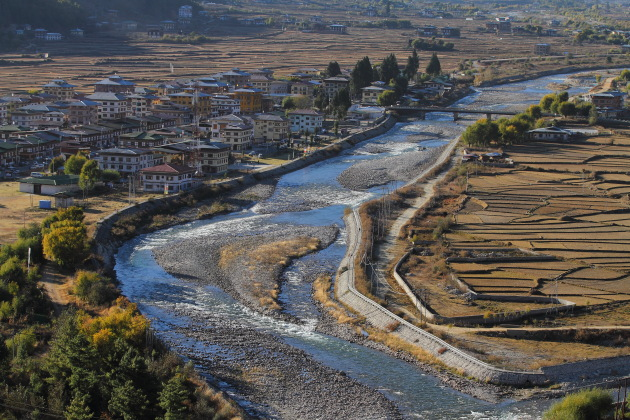Paro

Elevation 2,280 m
The broad Paro valley is the entry point for all visitors flying into Bhutan on the national carrier, Druk Air. As the plane takes a dramatic sweep into Paro, the flight captain usually warns relieved passengers not to worry if the aircraft’s wings appear to be almost touching the mountainsides.
Places to visit include the Paro Dzong, the National Museum housed in a round fortress called the Ta Dzong, and the ruins of the Drugyal Dzong, a 17th century fortress that used to keep invading Tibetan forces at bay, destroyed in fire in 1951.
Built amazingly on a cliff, it brings pride to the Bhutanese about the work of their ancestors. It is said that Guru Rinpoche arrived here on the back of a tigress and meditated at this monastery and hence it is called Tiger’s Nest Monastery, Taktsang Monastery.
This site has been recognised as most sacred and visited by Zhabdrung Ngawang Namgyal in 1646 and now visited by all Bhutanese at least once in their lifetime.
Built in 1692, it caught fire on 19 April 1998, that damaged the main structure of the building and some religious contents. The monastery was restored to its former glory in 2005. On a sunny day please do remember to carry sunscreen, water, walking stick and a hat.
An hour's hike to the cafeteria is also a vantage view whereby you can enjoy the stunning view of the monastery. Prayer flags adorn the cliffs and this is also where Guru Padmasambhava landed on the back of a tigress in the 8th century.
Other places of interest include:
Drukgyal Dzong - Built in 1647 by the great Shabdrung Ngawang Namgyal, father and unifier of medieval Bhutan, the Dzong was destroyed by an accidental fire and left in ruins as an evocative reminder of the great victories it was built to commemorate.
Kyichu Lhakhang - the oldest temple in Bhutan.
First-class accommodations in Paro are available at the Amankora Paro, Uma Paro and Zhiwa Ling Hotel.
The Amankora has 24 suites with natural earth walls, gently sloping roofs and wood-panelled interiors, burkhari wood-burning stoves and large terrazzo-clad baths.
Uma Paro has 29 rooms, including villas with its own spa, hot-stone bath, and pantry with butler access. The hotel offers holistic therapies, yoga, massage, hydrotherapy and other wellness activities.
Zhiwa Ling Hotel is the first Bhutanese-owned hotel in its class, with 45 fully appointed rooms. The hotel has Swedish underfloor heating, WiFi, a spa, meditation chapel, tea house and bar.
Options for mid-range accommodations are various, including Jankha Resort, Kishu Resort, Tashi Namgay Resort, Dechen Hill Resort and many others.